|
+Forging Part Design Class
.: a Symposium for Product Designers
and Mechanical Engineers :.
Course Duration:
16 hour workshop
(This two day class is offered each quarter so check the design engine
class schedule for exact dates or phone 312.226.8339.)
Tuition: $1000.00 US
Overview: The course and course material
is designed to provide a working knowledge of the metal forging industry.
The class is intended for those designers and engineers who are designing
forged parts. The bulk of your time in this workshop will be spent on
the part design requirements imposed on the designer by the forging process.
Covered in this workshop are such as approach to modeling forgings to
learning techniques where designers take a weldment and convert that assembly
into a forged part. Read On.
Prerequisites: General knowledge of Pro/ENGINEER
another 3dimensional CAD modeler helpful but not necessary.
Call to ask for a proposal to sign up your company into a week long on-site
cumulative workshop that encompasses all three manufacturing processes
classes design engine offeres. In this way participants can master and
leverage advanced modeling techniques with specific manufacturing processes
that makes for lighter, stronger parts with confidence. These classes
can be offered anytime requiring only two to make a class in our Chicago
office. 312.226.8339
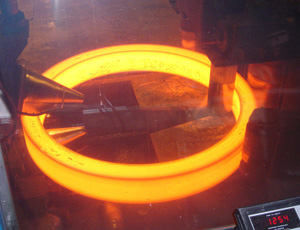 Forged
wheel. Forged
wheel.
Topics:
- Overview of the forging process complete with tooling, and outside machining
operations.
- Forging is process by which metal is heated and is shaped by plastic
deformation by suitably applying compressive force.
- Discuss the progression of a forging process.
- Open Die Drop hammer forging.
-- Impression-die drop-hammer forging.
- Press forging, upset forging, Automatic hot forging and roll forging.
- Powder mixes for compacting plus alloyed powder, composed of two or
more elements.
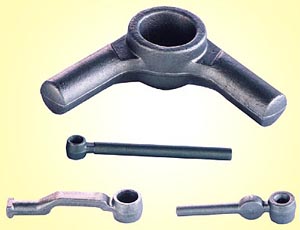
Forged brackets
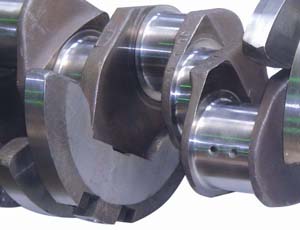
forged crank
Discussions:
- Discuss the history of forming metals
- Discuss the forging process and it's specific history
- Advantages and Disadvantages with respect to cost and strength
- Discuss alloys with respect forging.
- Compare Cold forging to hot forging to warm forging.
- In detail steps of the forging process
- Discuss strengths and weakness of outsourcing.
- Discuss basic design elements for forged part design. Holes, ribs, thin
wall features, bosses, nominal wall, and fill.
- Discuss general rules for forging and how material deforms so designers
can leverage flow for strength. impact flow
- Aircraft Quality for high stress forged parts.
- Discuss Auxiliary operations such as specific surface conditions or
specific shapes not obtained by the regular processing operation.
- Flow Stress with respect to deformation
- Discuss heat treatment
- Discuss draft requirements with respect to material flow
- joining the Forging Industry Association.
- Discuss specification and purchasing quantities or tooling specific
to forging.
- Cost reduction projects
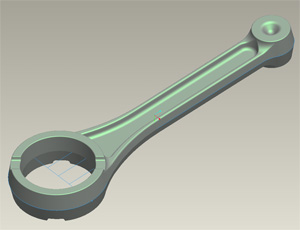
Harley Davidson forged Rod before machining features are added in Pro/ENGINEER.
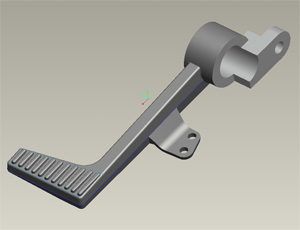
Completed Honda 600rr forged brake lever with 7 degrees draft. Screen
shot is from Pro/ENGINEER.
Pro/ENGINEER specific:
- Discuss draft in it's many forms complete with examples of split draft
etc.
- Discuss a light use or surfacing and discuss it's usefulness with forged
part design.
- Discuss top down design with examples on forged parts.
- Discuss adding draft to parts that currently have no draft.
- -Discuss making parts ready for the forging process that others created
i.e. technique, draft, strike direction.
- Techniques for converting multiple Pro/E parts from a weldment into
a cheaper stronger forged part.
- Discuss tips tricks and techniques for starting and completing forging
parts using Pro/ENGINEER.
- Learn to use parameters, relations and underlying curve geometry to
drive Pro/E geometry with respect to Forged parts.
- Discuss ribs and the addition of gage geometry for aligning for the
CNC matching process forge part.
- Learn to use Utilize Draft check correctly
- Discuss chrome applications and other plating, painting or powder coating
processes.
- Techniques for managing the Pro/E machining features.
- Techniques for mounting your forged part to your CNC machine (features
in Pro/ENGINEER)
- Participants will undergo a wide variety of case studies or excesses
using Pro/ENGINEER
- Prints, specification and notes for forging detail drawings.
There are HTML tutorials available for participants who will be able
to utilize after this workshop.
 Sample
forged parts and tools. Sample
forged parts and tools.
Compare:
- Compare Metal injection molding or Powder Injection Molding or PIM to
forging
- Forging process and product to Die casting process
- Die casting vs. forging process with respect to cost and qty.
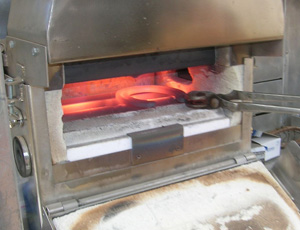 hand
forging a horse shoe hand
forging a horse shoe
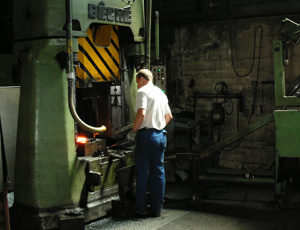 Hydraulic
drop-hammer Hydraulic
drop-hammer
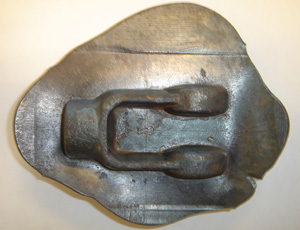 a
typical forging before a final trimming blow event a
typical forging before a final trimming blow event
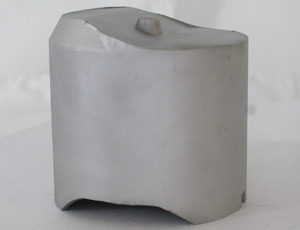
This raw aluminum piston forging shows just how “raw” a piston
is before it’s gone through several machine operations to complete
the product
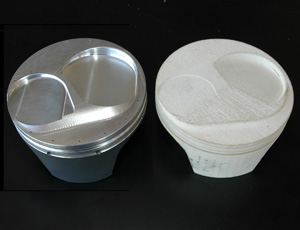
The piston on the right is a forged piston with a separate coat of powder
that is used as a bonding agent to seal the aluminum from absorbing water.
http://www.proetools.com/graphics/courses/y_12.jpg

Example of one of seven proe projects where techniques for complex draft
for forged parts make Pro/E easier.
|